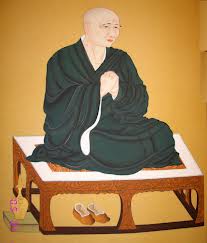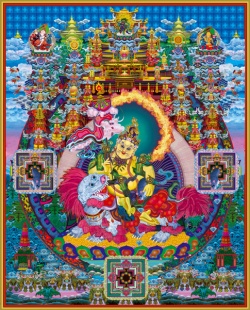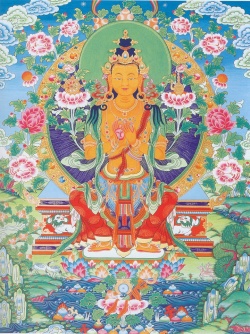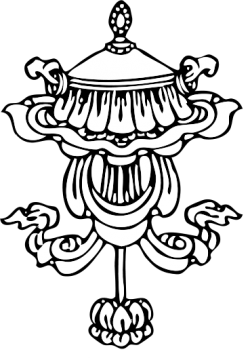Śrāvaka
- See also :
- See also :
Śrāvaka (Sanskrit) or Sāvaka (Pāli) or Shravaka means "hearer" or, more generally, "Disciple".
This term is used by both Buddhists and Jains. In Jainism, a Shravaka is any lay Jain. Thus the term Shravaka has been used for the Jain community itself (for example see Sarak and Saraogi).
In Buddhism, the term is sometimes reserved for distinguished disciples of The Buddha.
Buddhism
In Nikaya Buddhism, Sāvaka (m.) or sāvikā (f.) is a Disciple who accepts:
- The Buddha as their teacher,
- The Buddha's teaching (the Dhamma),
- The Buddha's rules of conduct (Five Precepts for laypersons, Patimokkha for monastics).
In Mahayana texts, śrāvakas (or Arhats) are sometimes contrasted with bodhisattvas (Sanskrit; Pāli: Bodhisatta).
Who's a "Disciple"?
In the Pali canon, the term "Disciple" transcends monastic-lay divisions and can refer to anyone from the following "four assemblies":
Buddhist texts further mention three types of disciples based on spiritual accomplishment:
- "Chief Disciple" (Pāli: aggasāvaka; Sanskrit: agraśrāvaka):
- In the Pali canon, the Chief Disciples are Sāriputta (Pāli; Sanskrit: Śāriputra) and Mahāmoggallāna (Pāli; Sanskrit: Maudgalyāyana).
- Examples of Great Disciples are Mahākassapa (Pāli; Sanskrit: Mahākāśyapa), [[[Ānanda]]]], Anuruddha and Mahākaccāna.
- Ordinary disciples, who constitute the majority of disciples, while devoted to The Buddha and his teaching and while having planted seeds for future liberation, have not yet irreversibly entered the path to emancipation and are still subject to infinite rebirths.
Ariya-Sāvaka
In the traditional Pali commentaries, the Pali term Ariya-Sāvaka is explained as "the Disciple of the Noble One (i.e. Buddha)". Accordingly Soma Thera and Thanissaro Bhikkhu translate this term as "The Disciple of the Noble Ones"
However Bhikkhu Bodhi interprets this term as "Noble Disciple", and according to him, in the Pali suttas, this term is used in two ways:
- broadly: any lay Disciple (Pāli: Upasaka, Upasika) of The Buddha;
- narrowly: one who is at least on the path to Enlightenment (Pāli: sotāpatti maggattha). In this sense, "ordinary people" (puthujjana) can be contrasted with this narrow definition of "Noble Disciple" (Ariya-Sāvaka).
The canon occasionally references the "four pairs" and "eight types" of disciples. This refers to disciples who have achieved one of the Four stages of enlightenment:
- stream-enterer (Pāli: sotāpatti)
- once-returner (Pāli: sakadāgāmitā)
- Non-returner (Pāli: anāgāmitā)
- Arahant (Pāli: arahatta)
For each of these stages, there is a "pair" of possible disciples: one who is on the stage's path (Pāli: Magga); the other who has achieved its fruit (Pāli: phala). Thus, each stage represents a "pair" of individuals: the path traveler (Pāli: maggattha) and the fruit achiever (Pāli: phalattha). Hence, the community of disciples is said to be composed of four pairs or eight types of individuals (Pāli: cattāri purisayugāni attha purisapuggalā).
In the Pali canon, The Buddha often contrasts the "instructed Disciple of the Noble Ones" (Pāli: sutavā Ariya-Sāvaka) with the "uninstructed worlding" (Pāli: assutavā puthujjana). For instance, in the "Sabbasava Sutta," The Buddha states:
- The well-instructed Disciple of the Noble ones – who has regard for Noble ones, is well-versed & disciplined in their Dhamma; who has regard for men of integrity, is well-versed & disciplined in their Dhamma – discerns what ideas are fit for attention and what ideas are unfit for attention.
"Foremost" disciples
In the "Etadaggavagga" ("These are the Foremost Chapter," AN 1.14), The Buddha identifies 80 different categories for his "foremost" (Pāli: agga) disciples: 47 categories for monks, 13 for nuns, ten for laymen and ten for laywomen. Some of these categories and the associated disciples are identified in the table below.
| CATEGORY | MONKS | NUNS | LAYMEN | LAYWOMEN |
| First | Kondañña | Mahapajāpati | — | — |
| Great / High Wisdom | Sāriputta | Khemā, Bhadda Kaccānā | — | — |
| Psychic Powers | Mahāmoggallāna | Uppalavannā | — | — |
| Discipline | Mahakassapa | Patacarā | — | — |
| Heavenly Eye | Anuruddha | Bakulā | — | — |
| Teaching / Knowledge | Mahakaccana, Punna Mantaniputta, Vangisa | Dhammadinnā | Citta (Macchikasandika) | Kujjuttarā |
| Foremost Layperson | — | — | Sudatta | Visakhā |
| First Taking Refuge | — | — | Tapassu, Balluka | Sujāta |
In addition, in SN 17.23, SN 17.24 and AN 4.18.6, The Buddha identifies four pairs of disciples "who have no compare" and who should thus be emulated. These four pairs are a subset of the 80 foremost disciples identified in the aforementioned Sutta AN 1.14. These four pairs of disciples to be most emulated are:
- monks: Sāriputta and Mahāmoggallāna
- nuns: Khemā and Uppalavannā
- laymen: Citta (Macchikasandika) the Householder and Hatthaka of Alavaka
- laywomen: Kujjuttara and Velukandaki the mother of Nanda (also known as Uttaranandamātā)
The community of disciples
In Buddhism, there are two main communities (Pāli: Sangha):
- The "community of monks and nuns" (Pāli: Bhikkhu-Sangha; Bhikkhuni-Sangha) refers to a community of four or more monks or nuns who are living in a permanent or semi-permanent single-sex community (in the contemporary West monks and nuns may live within the same monastery but in separate living quarters). Within this community of monks and nuns there is a further sub-division containing practitioners (who are nonetheless still living among their fellow renunciates) possessed of some substantive level of realization (namely, those who have at least gained stream-entry). This core group is called the "Noble Sangha" (Ariya-Sangha).
- The "community of disciples" (Pāli: Sāvaka-Sangha) refers to the broad community of monks, nuns, and male and female layfollowers.
For an example of a traditional stock reference to the Sāvaka-Sangha in the Pali canon, in "The Crest of the Standard" discourse (SN 11.3), The Buddha advises his monks that, if they experience fear, they can recollect The Buddha or the Dhamma or The Sangha; and, in recollecting The Sangha they should recall:
- "The Sangha of the Blessed One's disciples sāvaka-sangha is practising the good way, practising the straight way, practising the true way, practising the proper way; that is, the four pairs of persons, the eight types of individuals...."
A similar phrase can also be found in the lay Disciple's daily chant, "Sangha Vandanā" ("Salutation to The Sangha").
Mahāyāna view
In the 4th century Abhidharma work Abhidharmasamuccaya, Asaṅga describes those who follow the Śrāvaka Vehicle (Skt. śrāvakayanika). These people are described as having weak faculties, following the Śrāvaka Dharma, utilizing the Śrāvaka Piṭaka, being set on their own liberation, and cultivating detachment in order to attain liberation. While those in the Pratyekabuddha Vehicle (Skt. pratyekabuddhayānika) are portrayed as also utilizing the Śrāvaka Piṭaka, they are said to have medium faculties, to follow the Pratyekabuddha Dharma, and to be set on their own personal Enlightenment. Finally, those in the Mahāyāna (Skt. mahāyānika) are portrayed as utilizing the Bodhisattva Piṭaka, as having sharp faculties, following the Bodhisattva Dharma, and set on the perfection and liberation of all beings, and the attainment of complete Enlightenment.
According to Je Tsongkhapa (founder of the Tibetan Gelug School): "The Sutra on the Ten Levels (Daśabhūmika Sūtra) says that those who have cultivated these ten [[[virtuous]] practices, i.e. not killing, not stealing, not lying etc.] through fear of cyclic existence and without [great] Compassion, but following the words of others, will achieve the fruit of a Śrāvaka."
Jainism
Sravaka (श्रावक) in Jainism is a lay Jain. He is the hearer of discourses of Jain munis and scholars i.e. Jinavani.
The Jain chaturvidha Sangha includes monks, nuns, lay men (shravas) and women (shravikas). Thus the term Shravaka has been used for the Jain community itself. Saraogi the name of a Jain community, and sometimes the last name in some families, is derived from Shravak. The long lost Jain community in eastern India is named Sarak, recalling its jain background.
The conduct of a Jain shravak is governed by texts called Shravakacharas, the best known of which is the Ratnakaranda Shravakachara of Samantabhadra.
A Shravaka rises spiritually through the eleven Pratimas. After the eleventh step, he is no longer a shravak, but becomes a Muni.





